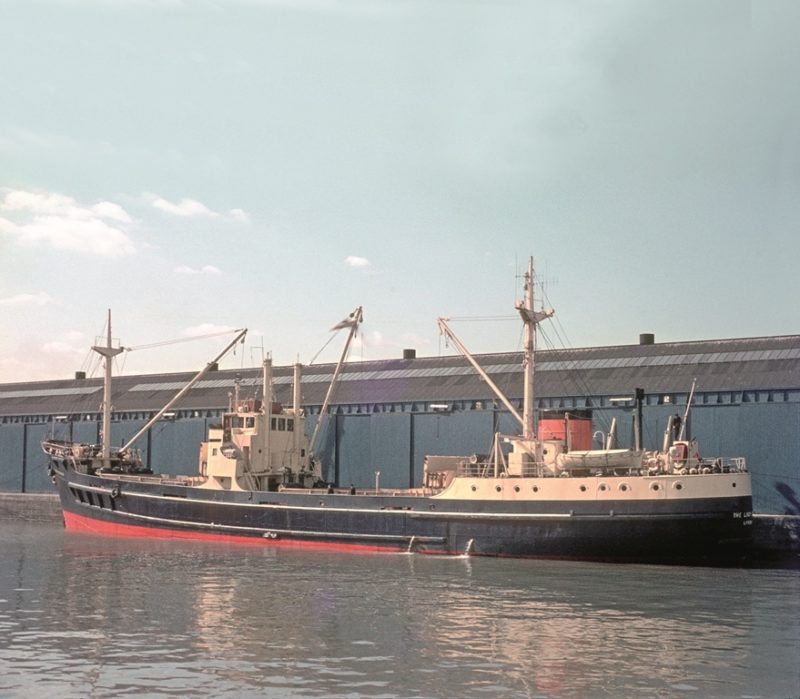
Beer has been carried around the world for centuries to slake the thirsts of British colonials and troops. The clipper ship Catherine Adamson sailed from Aberdeen to Sydney in 1857 with a cargo of 4,000 gallons of brandy, 5,000 gallons of wine, and 156 barrels of beer, but all of her much needed liquid cargo went to waste when she was wrecked off Sydney Heads. The still extant sailing ship Edwin Fox, built in 1853, made six long distance voyages loaded with beer, three of these to New Zealand. She also made a voyage from London when she sailed on 17th March 1869 for Madras with 1,700 hogsheads (85,000 gallons) of beer and arrived safely on 25th July after 137 days. She then sailed for the port of Masulipatnam, 220 miles up the coast from Madras but ran aground a day and a half out of Madras. The much needed beer of 446 hogsheads (200,000 pints) was thrown overboard to lighten the ship and refloat her. Such a waste of good, cool beer in a hot country! Edwin Fox was left to lie as a disintegrating wooden wreck at Picton in the north of the South Island of New Zealand until she was moved to a dry dock for preservation work to begin.
A modern day sailing ship was also nearly lost on 20th May 2019 some 35 miles off the Norfolk and Suffolk coasts. The Norfolk Brewhouse in Hindringham had teamed up with the French brewers Northmaen Brewery to brew Amitie, a special collaborative beer for Norwich City of Ale. Locally malted barley was used to produce it, and it was loaded on a blue and white hulled small sailing ship for transport to Rouen. The vessel was found drifting at the mercy of the waves, and the Harwich RNLI volunteer crew towed the vessel to safety.
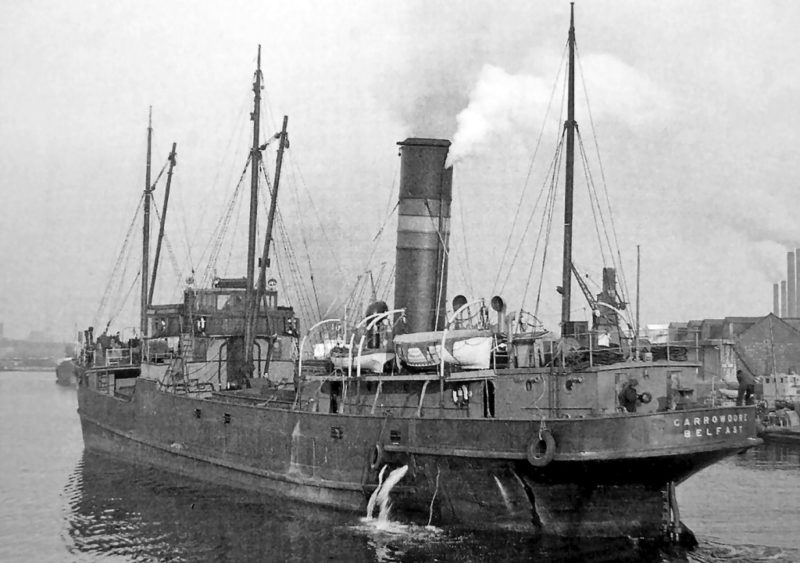
THE GUINNESS BREWERY
Guinness was originally called Porter or Porter Stout, and in the 18th and 19th centuries Guinness was transported throughout Ireland via the canals as the cheapest way of moving it to the western parts of the country. Wooden barrels (casks) were used at first, but pilfering was easy, thus metal casks were then used as they were much harder to tap and very much more hygienic. The main markets for the iconic strong stout today are Ireland, the U.K., the U.S.A., and Africa, the Africans having recently acquired a taste for the product.
Arthur Guinness signed a lease on a defunct brewery at St. James Gate in Dublin for an annual rent of £45 in 1759, just about the biggest business bargain of all time considering that today Guinness makes an annual profit of over £2 billion. A shipment of six and one half barrels of the product left the port of Dublin in May 1796 on a sailing vessel bound for England within a few decades of starting brewing. Guinness was shipped to the United States of America for the first time on 16th October 1817 from Dublin to South Carolina by sea in a big order for the time of eight barrels. However, the vagaries of early small sailing ships on the Transatlantic trade were at times unsurmountable, when constant gales were met, with a big loss of barrels. Today, smaller steel kegs are loaded into 40 feet long containers and driven to the Port of Dublin and loaded onto a feeder container ship for Southampton, Felixstowe or Continental container ports. Transit times using the big 20,000 TEU container ships of today are 21 days from brewery to New York, 26 days or more for Charleston, Norfolk (Va), and Houston, and between 33 to 36 or more days to Los Angeles in California.
The production of Guinness at St. James Gate had made it the largest brewery in Ireland in 1838 and the largest in the world with production having reached 1.2 million barrels per year in 1886, and twenty years later the St. James Gate brewery was employing 3,240 men, which with dependants accounted for one in 30 of the Dublin population. Today, ten million glasses of the product are drunk around the world every day in 50 countries and it is sold on to 150 countries. A pint of Guinness accounts for the more than half of all the pints of beer drunk in Ireland today. The Guinness Storehouse is the most popular tourist attraction in Dublin today, and is the Guinness museum, with well over four million visitors since it opened in Millennium year. The St. Patrick Day celebrations around the world on each 17th March results in the consumption of more than 13 million pints of the product on that day. It remains today as the largest brewer of stout in the world, but was taken over in 1997 in a merger with Grand Metropolitan Hotels to form Diageo, a British company.
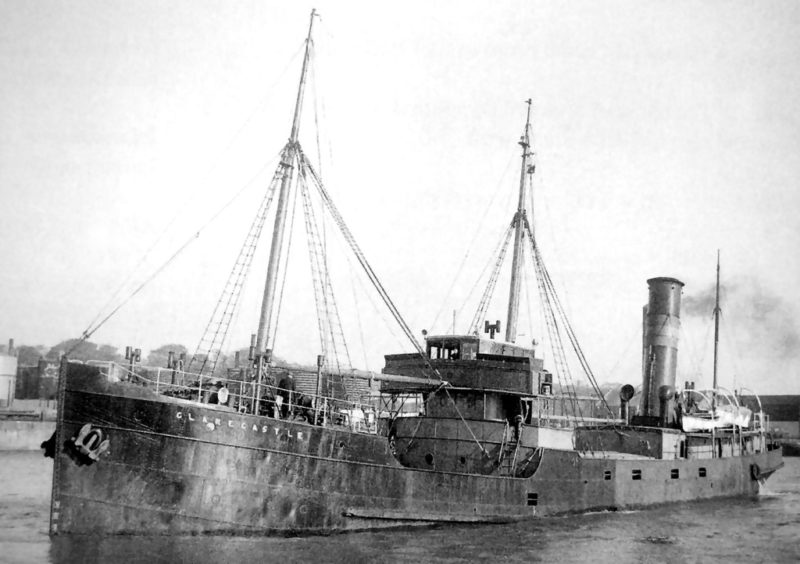
Liner companies such as the British & Irish Steam Packet Co. Ltd. (B + I) calling at Dublin loaded the product in pre-booked space for transport to England together with rail steamers to Holyhead and Burns & Laird ships to Glasgow, and ships of Palgrave, Murphy, then chartered ships took the product around the world until a thriving export trade had grown up. The nuclear powered ship Savannah loaded a cargo of 6,000 cartons of bottled Guinness stout in 1964 for ports on the Eastern Seaboard of the United States of America.
In 1913, the company bought its first ship, the engines ‘midships steam collier W. M. Barkley, of 569 grt and built in 1898, from James Kelly of Belfast. A further three more ships were purchased between 1913 and 1917, these being the engines aft Kelly colliers Carrowdore of 598 grt, Clareisland of 633 grt and Clarecastle of 627 grt. They worked the Liverpool, Manchester and London routes and were fitted with refrigeration equipment to maintain the stout in perfect condition, with empty casks carried on the return voyage. W. M. Barkley was sunk by torpedo from UC 75 at 1900 hours on 12th October 1917 with the loss of five crew seven miles east of the Kish Lightship on a voyage from Dublin to Liverpool with stout. Capt. E. Gregory from Arklow, First Engineer A. Corry from Dublin, Second Engineer O. F. Murphy from Wexford, Able Seaman A. Kendall from Dalkey, and a fireman were all lost, but nine survived including cook Thomas McGlue and a gunner and were rescued by the collier Dunnet Head.
The three remaining former Kelly colliers of the fleet of Arthur Guinness & Sons Ltd. of Dublin carried on throughout the remaining war years, with all three requisitioned for war duties e.g. as colliers for the battle fleet or carrying hay to the horses in the European conflict. Carrowdore later suffered bomb splinter damage in World War II in July 1941 when a bomb ricocheted off her into the water and exploded causing minor damage. They returned to Guinness stout carriage in 1919 to Liverpool and Manchester, and were joined in May 1931 by the first purpose built beer boat in the twin masted engines aft Guinness of 1,151 grt from the yard of the Ailsa Shipbuilding Co. Ltd. at Troon. Clareisland was now redundant and was sold off to the Antrim Iron Ore Co. Ltd. in 1931.
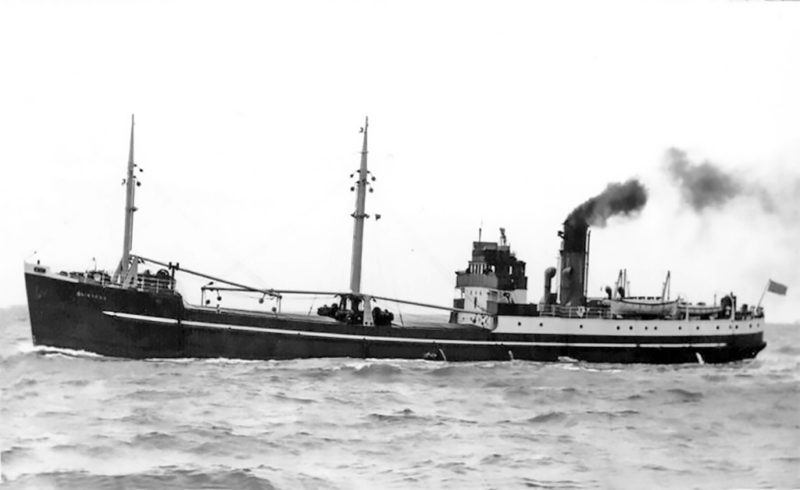
Guinness was a cruiser sterned vessel fitted with refrigerated machinery on her single steel deck, with dimensions of overall length 211.8 feet, moulded beam of 28.6 feet, moulded depth of 15.8 feet with a fo’c’stle of length 27.0 feet. She carried 228 tonnes of water ballast in double bottom compartments and the forepeak and aft peak.
The vessel Guinness carried 800 tons of stout in a cooled and insulated hold to London from 1931 to 1938, when Guinness began to be brewed at the new Park Royal brewery in London, and she was then transferred to the Manchester route. The company houseflag was a swallow tailed red flag carrying a black ‘G’ in the centre, with the burgee made of wool or synthetic fibre bunting and had a cotton hoist. The three ship fleet of Guinness, Clarecastle and Carrowdore survived World War II intact, but after the war new 550 gallon aluminium or stainless steel tanks began to be used to replace the wooden or steel barrels (casks). Carrowdore and Clarecastle were replaced in the fleet in 1952 by two ‘Lady’ motor vessels with air conditioned temperature controlled holds to keep the iconic stout in perfect condition during transit.
The Lady Grania of 1,152 grt and 860 dwt came from the Ailsa yard at Troon in 1952, The Lady Gwendolen of 1,166 grt and 840 dwt came from the Ardrossan yard in 1952, and The Lady Patricia of 1,187 grt and 920 dwt came from the Charles Hill & Sons yard at Bristol in 1962 at a cost of £280,000. The Lady Grania and The Lady Gwendolen were of 197 feet overall length and were fitted with British Polar diesel engines to give a service speed of ten knots, while The Lady Patricia was fitted with an uprated British Polar diesel engine to give a service speed of 11 knots. The Lady Grania carried 120 of the new 550 gallon steel tanks in her aft hold and 1,100 casks or hogsheads (large casks of 50 gallon capacity) in the forward hold to give a total carrying capacity of 113,160 gallons of stout. The Lady Gwendolen was named after the wife of Lord Iveagh, and The Lady Patricia was named after his daughter.
Further tank developments of fitting large tanks to fill the holds of The Lady Grania and the stout pumped directly from shore into these tanks, the work being carried out at the Bristol yard of Charles Hill & Sons Ltd. in May 1973, and these were successful, with The Lady Patricia similarly converted in November 1973. She had been initially fitted with 296 transportable 550 gallon tanks, and at the end of 1973 she sailed to all intents and purposes as a beer tanker.
A purpose built beer tanker made her maiden voyage on 26th January 1977 under Capt. John Quirk as Miranda Guinness from the Port of Dublin to Runcorn. She carried the name of the wife of the third Earl of Iveagh, Benjamin Guinness and Chairman of the company between 1962 and 1986. She was fitted with fifteen stainless steel tanks carrying a total volume of 6,500 barrels, or around 2 million pints of stout, and made two voyages per week from Dublin to Manchester.
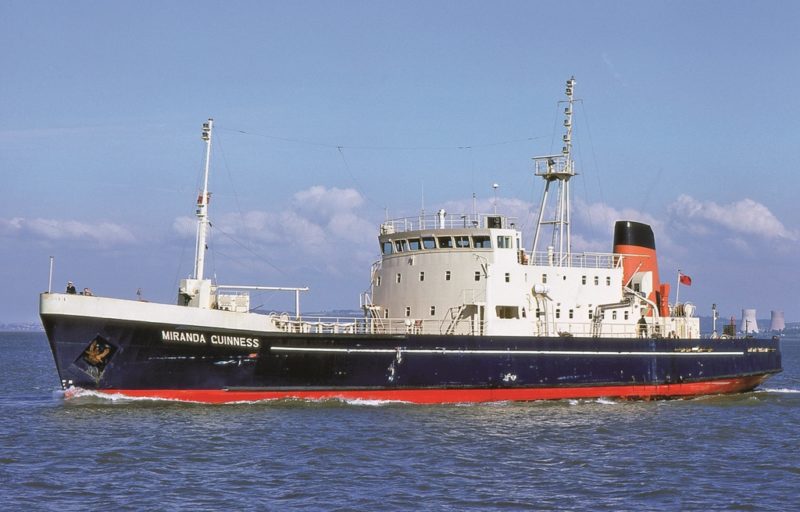
However, management of the Arthur Guinness & Sons Ltd. fleet was taken over in 1987 by Irish Marine Services Ltd., and the fleet then went into a decline as the company opened new Guinness breweries all over the world and marine carrying of the iconic stout in owned vessels stopped in 1993. The Lady Patricia and Miranda Guinness made their last voyages out of the Port of Dublin in April 1993 with cargoes for Manchester, and were sent for breaking up within a month of being laid up on the Manchester Ship Canal. The complete Guinness fleet list reads as follows:-
W.M. Barkley (1913-1917)
Carrowdore (1914-1953)
Clareisland (1915-1931)
Clarecastle (1915-1953)
Guinness (1931-1963)
The Lady Grania (1952-1976)
The Lady Gwendolen (1953-1976)
The Lady Patricia (1962-1993)
Miranda Guinness (1977-1993)
In addition, the last six company barges that were in operation from Victoria Quay in Dublin to Limerick and Ballinasloe via the Irish canals until the start of 1960 had the names Killiney, Castleknock, Clonsilla, Sandyford, Seapoint and Howth. Guinness barges had been used since 1868 and could carry 300 hogsheads of stout.
EAST COAST BEER BOATS
Burton on Trent breweries were extensive and accounted for one quarter of all U.K. beer production, with much of the town given over in the 19th century to the industry, and brewing families dominated it politically and socially. The names of Bass, Ratcliff, Gretton, Evershed, Wardle, Yeomans and Allsop became synonymous with Burton, both nationally and internationally. William Bass began brewing at Burton in 1777 with the brewery purchased 223 years later in 2000 by Coors of the U.S.A. Bass and many other brewing families were selling upwards of 100 million barrels of beer per year at the peak, and transporting it by barge down the Trent to Hull for shipment. The ships of Ben Line, Ellerman Wilson Line, United Baltic Corporation, Associated Humber Lines, and smaller coastal firms carried beer across the North Sea and further afield. One North Yorkshire brewer today ships 25,000 bottles of beer to the Continent each month through the Port of Hull. However, in North East Scotland and North East England, there were dedicated beer boats transporting barley for beer production, or beer for bottling, or for the carriage of the product to overseas countries for all of their careers.
MESSRS DEUCHAR BREWERIES at NEWCASTLE and MONTROSE
James Deuchar (1849-1927) was born at Guthrie in Forfar and moved to Tyneside with his three elder brothers Alexander, George and Robert. He began work as a publican in the Argyle Hotel in High Street of Gateshead, which still stands, and in 1870 purchased the Arthur’s Hill brewery on Westgate Road in Newcastle. He then began acquiring a string of hotels and pubs to build up a large strong beer business. Robert Deuchar followed his younger brother into the brewing industry by purchasing the Sandyford Stone brewery in east central Newcastle in 1888, with the Head Office completed in 1904, whose markings of Robert Deuchar Ltd. are visible today on the buildings. Robert Deuchar Ltd. was registered in 1897 and he purchased the Duddingston brewery near Edinburgh from Pattinson in 1899, and a year later acquired Simpson & McPherson with breweries in Melrose and Edinburgh together with their Tyneside pubs. Robert Deuchar died in 1904 as a rich man, having built up a similar big string of hotels and pubs to his brother on Tyneside and Wearside. The Deuchar beers were in big demand as well as strong ales, and the pale ale brewery of William Ross & Company at Montrose was acquired in 1900. A large warehouse and bottling plant were built on Newcastle Quayside to bottle the pale ales shipped in owned coasters from Montrose. In 1922, the Union Mills in Montrose were purchased for use as maltings, with farming for barley on a huge 13,000 acres of fields on the English and Scottish borders near Kelso. James Deuchar died at Stichill House near Kelso on 12th December 1927, his company having paid handsome dividends of between 20% and 40% during his long career. His estate was valued at £1.33 million, which is a huge amount in the money of today, and his firm of James Deuchar Ltd. was taken over by Scottish & Newcastle Breweries Ltd. in 1956. The Sandyford Stone brewery of Robert Deuchar Ltd. was taken over by S. & N. later.
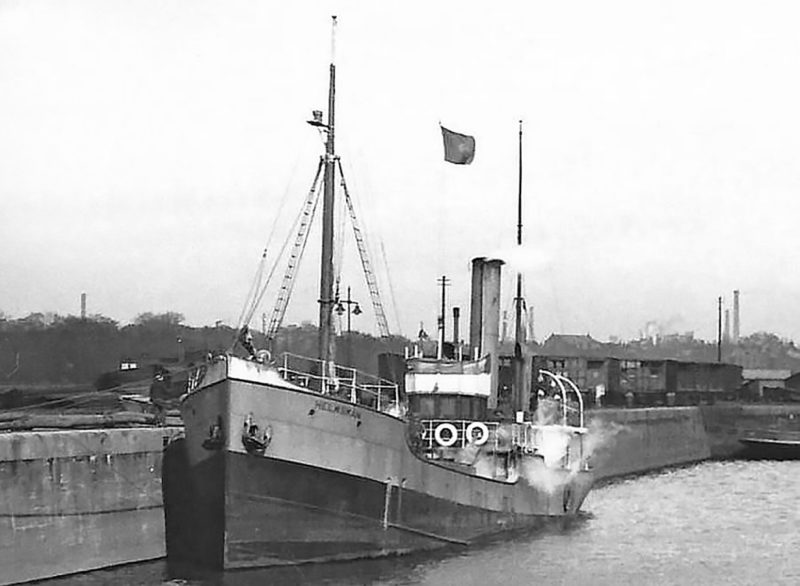
Messrs Deuchar transported pale ale for bottling from their Montrose brewery to their bottling plant and warehouse in Newcastle for almost a century. A chartered ship was used from 1884 when completed by Wallsend Slipway on the Tyne as Locksley, an iron screw ketch of 131 grt with machinery aft. Messrs Deuchar introduced their own steam coaster Lochside of 242 grt in 1905, with Locksley off charter and owned by R. V. Mitchell of Montrose until she was wrecked off Emmanuel Head on Holy Island in 1934. Lochside was completed by T. & W. Smith at North Shields as a coaster with an iron deck and a steel screw hull, and was said to have been commandeered during World War I by Russian forces and sailed out of St. Petersburg. She was returned to Messrs Deuchar in 1918 and sailed to the Tyne until she was sold to Rowbotham & Sons in 1925 and converted into a coastal tanker named Helmsman. She was unfortunately lost with all hands on 27th October 1927 on a voyage from the Medway to Stockton carrying petrol, but the ship and crew were never found. She encountered a severe gale on her last voyage, with hurricane force winds recorded in the vicinity of the East Dudgeon and Humber Light Vessels.
Lochside II was a quarterdecker steel hulled coaster of 368 grt and overall length of 140.0 feet and moulded beam of 24.0 feet and a forward well deck when completed by Smith’s Dock Co. Ltd. at the South Bank yard at Middlesbrough in June 1925. She was engines aft and powered by a two cylinder compound engine by Shields Engineering Ltd. at North Shields, a yard with an engine output that was almost always fitted in trawlers, with a busy dry dock for their repairs. She carried well over two million barrels of Messrs Deuchars brews for the thirty years of her career, with 1,450 barrels per week between Montrose and the bottling plant at Newcastle. She also carried barley to Montrose for beer production, and other cargoes in winter when her regular trade was quieter e.g. fertilisers to Berwick on Tweed and coal to the Orkneys and Shetland. She was sold to Danish owners and converted to diesel propulsion, and had a further long career until she was broken up at Morlaix. Lochside and Lochside II had the nicknames of ‘The Beerie’ when they sailed from the Lochside brewery at Montrose to Tyneside.
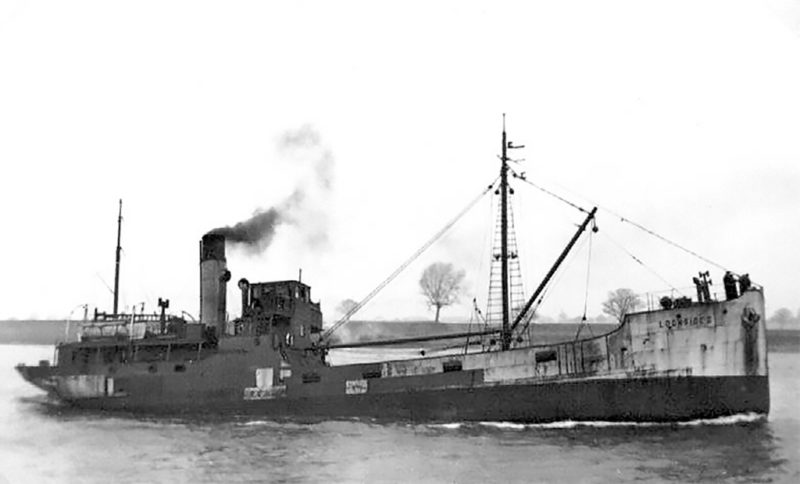
SCOTTISH AND NEWCASTLE BREWERIES
Scottish & Newcastle Breweries Ltd. owned the Fountain Brewery in Edinburgh (closed in 2004) and the Tyne Brewery in Newcastle (closed in 2005).
The Fountain Brewery was founded by the Syme family in 1749 and developed into the famous Scottish firm of William Younger & Company.
It merged with McEwans in 1931 becoming Scottish Brewers, and again in 1960 it merged with Newcastle Breweries Ltd. to form Scottish & Newcastle Breweries Ltd.
John Barras & Company was founded in Gateshead in 1770, and 120 years later it became the foundation of Newcastle Breweries Ltd.

The famous five pointed Blue Star logo of the company represented the five breweries that merged together in 1890 to form Newcastle Breweries Ltd., which were:-
John Barras & Company of Gateshead and Newcastle
W.H. Allison & Company of North Shields
Carr, Brothers & Carr of North Shields
Swinburne & Company of Gateshead
J.J. & E. H. Allison & Company of Sunderland
The iconic ‘Newcastle Brown Ale’ was first brewed in Newcastle in 1927, by which time the Haymarket Brewery of John Sanderson & Sons and the Fosters Bishop Middleham brewery in Central Durham had been taken over. Sales of ‘Newcastle Brown Ale’ soared in the inter-war years, with the Newcastle Breweries owning a large number of pubs on Tyneside, Teesside, Northumberland, Durham and North Yorkshire.
During the period 1953/59, the businesses of Robert Deuchar Ltd., James Deuchar Ltd., Northern Wine Traders Ltd., and John Rowell & Son Ltd. were acquired.
In 1956, the Montrose brewery of James Deuchar Ltd. was closed and sold as a whisky distillery, with Robert Deuchar’s brewery and Rowell’s of Gateshead closed shortly afterwards.
Instead of individual bottles, or wooden or steel barrels (casks) or later smaller steel kegs, 550 gallon steel tanks were being shipped in the early 1960s in the coasters of the Tyne-Tees Steam Shipping Co. Ltd., full of ‘Newcastle Brown Ale’.

These coasters were Cyprian Coast of 508 grt, Durham Coast of 586 grt, Frisian Coast of 586 grt, Grampian Coast of 481 grt, Hampshire Coast of 1,224 grt, Iberian Coast of 1,188 grt, Netherlands Coast of 867 grt, Northumbrian Coast of 1,180 grt, Novian Coast of 507 grt, Olivian Coast of 749 grt, Sylvian Coast of 749 grt, Suffolk Coast of 541 grt, and Yorkshire Coast of 785 grt, with Stormont of 906 grt the last of the fleet to be sold off in 1976.
This fleet sailed with the tank beer to East Coast ports including London, and to French Channel ports, and ports in Belgium, Holland and Germany.
Deep sea cargo-liners of the Ellerman fleet transported the product to South Africa, Cairn Line ships to Canada, and Swedish Lloyd ships to Sweden from Newcastle Quay, with other chartered ships for destinations around the world. Export of beer in 1952 from the Port of Tyne totalled 9,342 tons of many brands, today beer is handled as part of the 71,000 containers passing through the port each year.
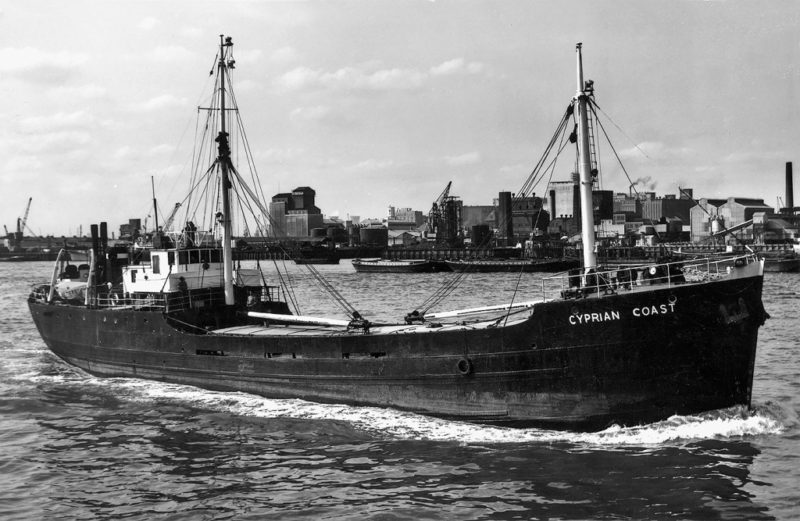
Bulk transport of beer took over in the early 1960s from individual bottling plants, or wooden and steel barrels (casks), during the ‘keg revolution’ of this period. Keg racking and keg washing went through several phases of development, with kegs initially hand filled (similar to cask filling) on a racking system.
Keg beers were sold as such and were given new names to differentiate them from cask beer tastes. Automated keg rackers then came along with up to 12 to 18 separate washing and racking lines to give the ultimate in bulk beer production.
Production of ‘Newcastle Brown Ale’, ‘Exhibition Ale’, ‘IPA’ and ‘McEwans Best Scotch’ were switched to the Federation Brewery in 2005 at Dunston on Tyne near the Metrocentre, with ‘Federation Strong Brown Ale’, ‘Federation Special Keg’, ‘Duddingstons’ and ‘Federation Diet Lager’ as their beers.
Then in 2010, ‘Newcastle Brown Ale’ was switched to John Smith’s brewery at Tadcaster in North Yorkshire for U.K. sales.
Export sales are handled today around the world by brewing the iconic beer at the Zoeterwoude Brewery in the Netherlands and also by the Lagunitas Brewery in Chicago for sales throughout the Americas.
Scottish & Newcastle Breweries Ltd. were taken over on 25th January 2008 by a consortium of Heineken and Carlsberg for £8.00 per share. The acquisition was completed on 29th April 2008 when the shares of the company were delisted from the London Stock Exchange.
The site of the famous Tyne Brewery near the St. James Park football stadium of Newcastle United was taken over by the new Science City of Newcastle University for science, naval architecture and other technical departments.
The Head Office of Newcastle Breweries Ltd. was in the Haymarket in Percy Street, and was designed and built by Joseph Oswald between 1896 and 1900, this red sandstone and brick building has quirky Flemish gables, a corner turret, and has beautifully decorated and glazed interiors.
The building still stands today although with a different usage.
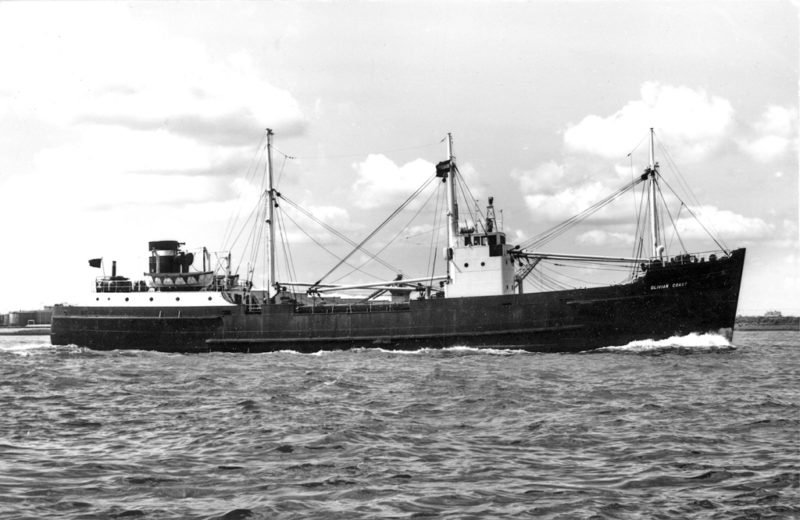
NORWICH BREWERIES
In 1836, Norwich on the river Yare had 27 breweries, and by acquisition and takeover these breweries expanded and consolidated until there were only four left in the 1920s. These were Bullards, Steward & Patteson, Morgans, and Youngs Crawshay & Youngs. In 1958, Bullards bought Youngs, and subsequently partnered Steward & Patteson in the purchase of Morgans, only for Watney Mann to takeover both of the remaining brewers in August 1961.
The Norwich beers included the strong ‘Norwich Brown Ale’, the keg beers of ‘Starlight’, ‘Norwich Bitter’, ‘Norwich Mild’, ‘S & P Bitter’ and many small brews with intriguing names and histories.
The Port of Norwich became fully operational in 1927 with King Street as the centre of the brewing industry, with the brewers using the river Yare for the import of barley and the export of casks of their excellent beers.
The barges, tugs and smaller ships of the Great Yarmouth Shipping Company e.g. Boston Trader of 371 grt, Lowestoft Trader of 311 grt, Lynn Trader of 404 grt, Norfolk Trader of 457 grt, and Norwich Trader of 377 grt, and the smaller coasters of the General Steam Navigation Company (GSNC), which took over the Great Yarmouth Shipping Co. Ltd. until it closed down in 1971, as well as the small river coasters of Everards were used.
The funnel colours of the Great Yarmouth Shipping Co. Ltd. were yellow with a black top, and the company had a fleet of between eight and ten small coasters, mostly engines aft, in the range of 200 grt to 400 grt throughout the inter-war years and World War II. The river Yare has many twisting bends and dead ends, and there was always the possibility of a ship ending up aground in a serious position at right angles to the flow of the river to await refloating at the next high tide.
An Everards coaster lay in this position for some time before refloating.
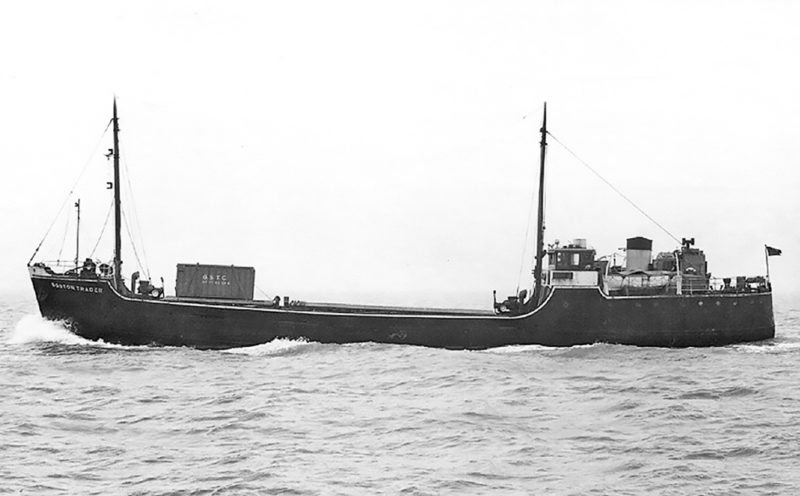
POSTSCRIPT
The Grand Canal of Ireland moved Guinness from Dublin to Limerick and the Shannon in a period of five days over a length of 82 miles with 43 locks and was completed in 1804.
The Grand Canal begins at the Grand Canal Lock on the Liffey and conveniently passed the St. James Brewery of Guinness, with one of the purposes of the canal being to supply fresh water to the brewery. The Royal Canal in Ireland linked Dublin to Lucan, Maynooth, Kilcock, Johnstown Bridge and Longford in Central Ireland, and was completed in 1817 at a cost of £1.421 million, thus bankrupting the Royal Canal Company. This canal is immortalised in verse by Brendan Behan in ‘The Auld Triangle’, and a monument to him was erected on the canal bank near Binn’s Bridge in Drumcondra in 2004.
The canal is 90 miles in length, and carried the iconic stout in Guinness owned barges to central Ireland, with the Barrow Navigation as a third canal was a spur off the Grand Canal for Guinness stout heading south to Wexford.
The Grand Union Canal in England provided the same means of transporting barrels and casks of beer from the big breweries of Burton on Trent to Regents Canal Dock in London via the Trent Junction.
The last pints of Guinness passed along the Grand Canal of Ireland in 1960, and this was also the high water mark of the great breweries of England and Scotland.
In addition to the dedicated Guinness and beer boats described in this article, there were other coasters who carried part cargoes of barrels, casks and kegs of beer around the coasts, or returned to the brewery with a full cargo of empty barrels to brew more pints. This was a regular cargo for coasters of other British companies returning the empties from smaller ports that the big Guinness and beer companies did not visit.
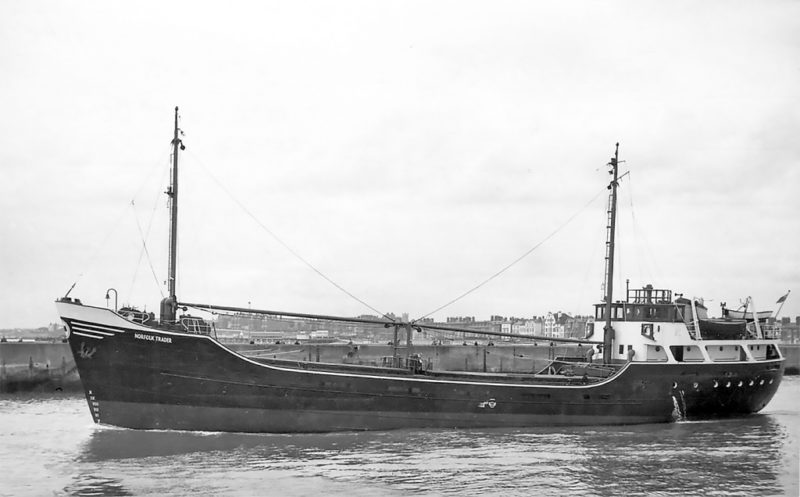
I wish to thank the Guinness Storehouse in Dublin and an article written by Aiden McCabe on the Guinness boats with the writing of this article having made me quite thirsty, now where did I put the bottle opener…?

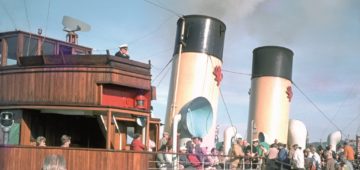



Comments
Sorry, comments are closed for this item